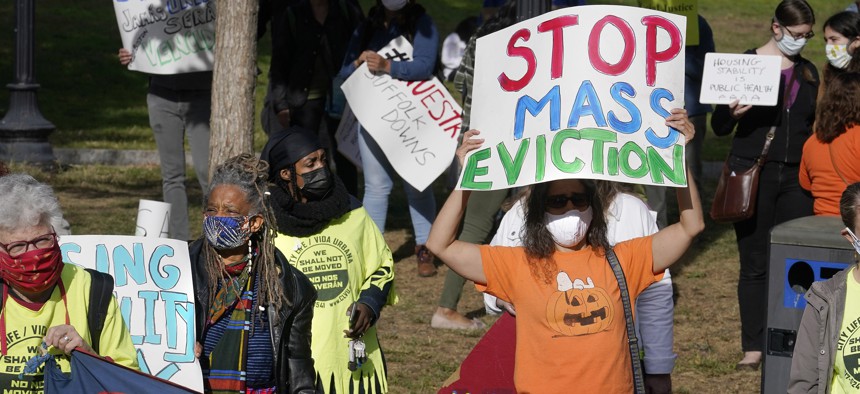Treasury Releasing $13B More in Rental Aid to Successful Programs

Protesters display placards while calling for support for tenants and homeowners at risk of eviction during a demonstration, Sunday, Oct. 11, 2020, on the Boston Common, in Boston, as the state weathers the ongoing COVID-19 crisis. AP Photo/Steven Senne
At least 50 state and local government grantees have met funding distribution benchmarks that would make them eligible for additional money.
State and local governments that distributed a substantial percent of their emergency rental assistance funds will now have access to a remaining $13 billion in aid to bolster relief efforts.
The U.S. Treasury Department announced this week it will make the remaining funds available to “high-performing state and local government grantees.” That includes Philadelphia; Honolulu city and county; New Orleans; Des Moines and Polk County, Iowa; Houston and Harris County, Texas; and Leon County, Florida.
Approximately $47 billion in emergency rental aid was allocated to grantees in two tranches of funding this year, but $13 billion has yet to be distributed. To be eligible for the remaining amount, grantees must have spent all their allocation from the first tranche and obligated at least 75% of the second, according to the Treasury Department.
The move by the Treasury Department to make the remaining $13 billion in emergency aid available will reward those state and local agencies that got rental assistance programs up and running. Approximately 50 grantees have spent more than 70% of their first emergency rental allocations and will likely be eligible to receive a portion of the remaining funds, the department said.
But the ability of state and local governments to get assistance to renters has been uneven across the country. Through the end of July, only about $5 billion of the first tranche of funding has been spent by all grantees, according to Treasury Department data. Nine states and dozens of cities and counties have spent less than 5% of their first allotment of funds, Diane Yentel, the president and CEO of the National Low Income Housing Coalition, testified before Congress last week.
The Biden administration has chided state and local governments for not getting assistance to renters more quickly, especially since the U.S. Supreme Court ended the federal eviction moratorium that had been shielding most tenants from losing their homes. But government officials have had to design emergency rental programs from scratch and it’s taken time for them to craft eligibility rules and find partner organizations to spread the word to tenants.
To help simplify and speed up the process of getting money to eligible renters, the Treasury Department previously released guidance intended to streamline the application process. It also put state and local governments on notice that they could lose out on emergency rental assistance money if they don’t start spending it soon. The Treasury Department will “recapture excess funds that have not been obligated … and reallocate those resources to high-performing jurisdictions” if grantees have not spent at least 65% of their original allocation by Sept. 30.
Reallocating unspent aid is “not an uncommon practice,” said Samantha Batko, a senior research associate at the Urban Institute’s Metropolitan Housing and Communities Policy Center.
“But certainly, it does leave people who are in those jurisdictions at a disadvantage,” she said of renters living in jurisdictions that have not distributed rental assistance aid and could see it reallocated. “It leaves potentially vulnerable renters without resources.”
In its announcement this week, the Treasury Department said it plans to share further details about the reallocation process in the coming weeks, including the spending thresholds that grantees must meet in order to avoid having their funds reallocated to other jurisdictions.
Andrea Noble is a staff correspondent with Route Fifty.
NEXT STORY: The Key to Stronger Local Democracy: Equitable Engagement





